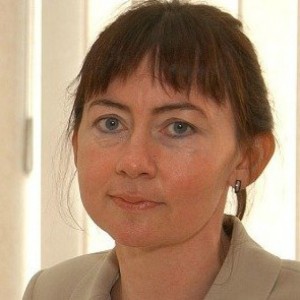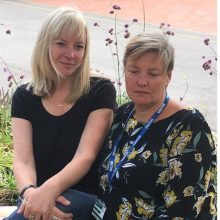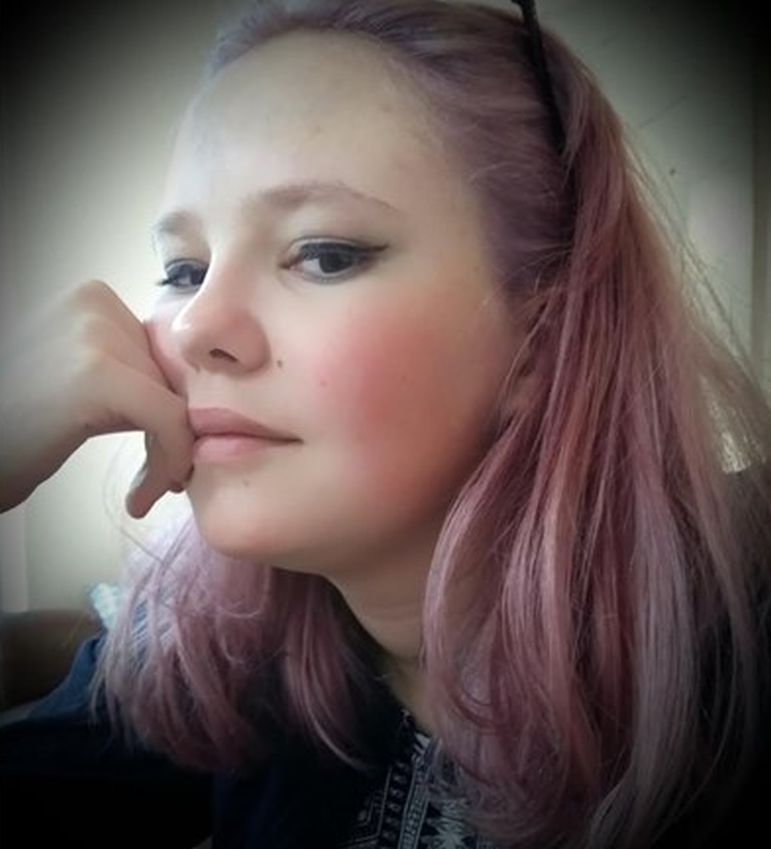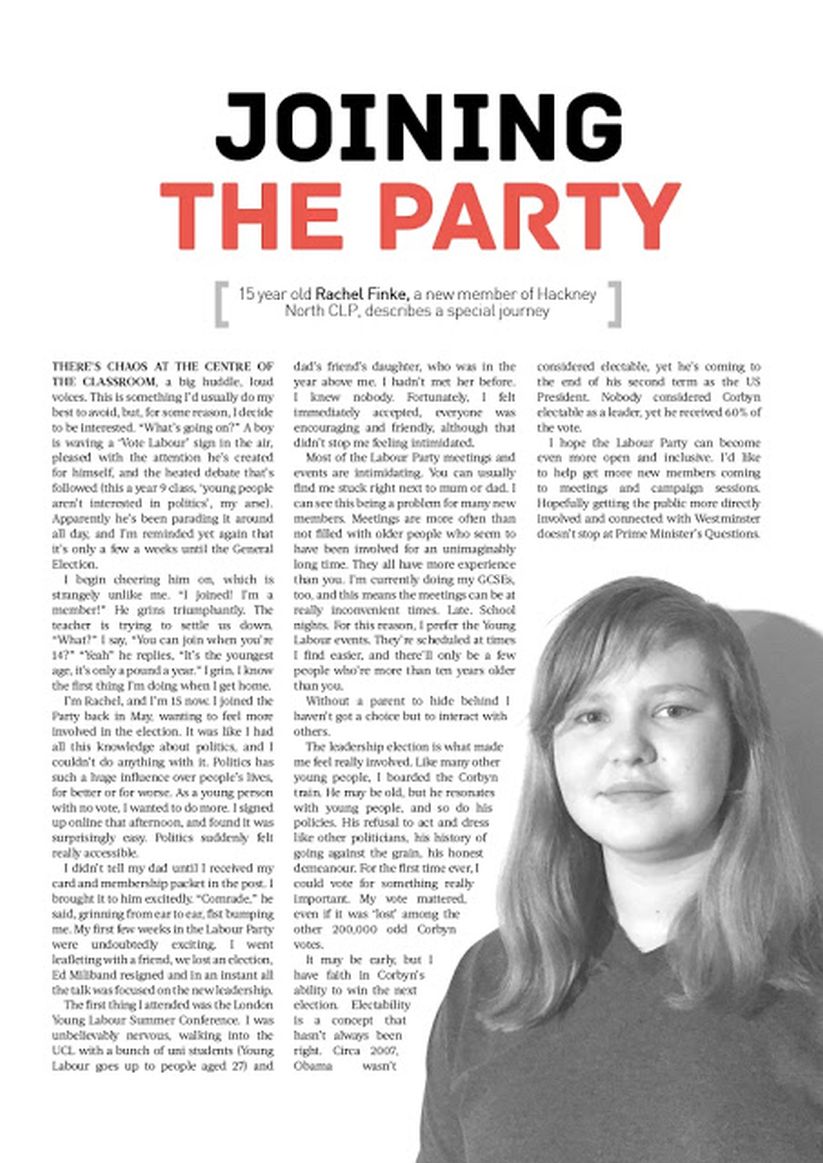On January 9th this year, 16-year-old Rachel (top) left her school in Stoke Newington, London, at lunchtime and took her life in a nearby park.
 Rachel’s mother Sarah (left) wrote to me in May, to tell me that, five weeks before she died, Rachel had been prescribed Sertraline. Sarah was convinced that the medication was the key factor to her acting so finally and violently.
Rachel’s mother Sarah (left) wrote to me in May, to tell me that, five weeks before she died, Rachel had been prescribed Sertraline. Sarah was convinced that the medication was the key factor to her acting so finally and violently.
In the course of corresponding with Sarah, I learned that, during the last year of her life, Rachel had been treated by City and Hackney CAMHS, where, at one time or another, she had been prescribed antidepressants Fluoxetine and Mirtazapine while she was just 15 years old. In March 2016, Rachel was also given Melatonin, which she continued to take until her death. Melatonin is usually prescribed for insomnia, and is linked to suicidal thoughts, particularly in girls and young women aged from 10 to 19 years.
Rachel’s inquest was held on three separate days spread over 19 days between June 30th and July 18th. There were no reports in the local media. After its conclusion, Sarah decided that she would like Rachel’s story to be told. These are Sarah’s words:
Who was Rachel?
My daughter Rachel was a one-off, a bolt of lightning. She did a lot in her short life. She was enthusiastic, fiercely bright and surrounded by people who, as her uncle said, “didn’t just love her, they really liked her.”
 She hiked with Scouts through Epping Forest in the night. She loved her running club (right). She played beautiful piano music and a passable ukulele. She practised guitar with her Dad. She joined Young Labour and canvassed. She went to see bands, old and new. She stood on the top of a volcano. She swam in the Caribbean and Aegean Seas. She was an extraordinary writer. Had she lived, she could have done so much more, been more places, changed things. One friend said: “She was the cleverest person I knew.”
She hiked with Scouts through Epping Forest in the night. She loved her running club (right). She played beautiful piano music and a passable ukulele. She practised guitar with her Dad. She joined Young Labour and canvassed. She went to see bands, old and new. She stood on the top of a volcano. She swam in the Caribbean and Aegean Seas. She was an extraordinary writer. Had she lived, she could have done so much more, been more places, changed things. One friend said: “She was the cleverest person I knew.”
She got her friends to do things with her. “She was the person who most inspired me in my life. I started running because of her,” said one girl.
She was brave, really funny, and brilliantly loyal. She was also supportive and empathetic. Her school sent me a book that a lot of the pupils had written in. Everyone remarked on her kindness. One girl said that when she was feeling bad about herself she would go to the library, and Rachel would be there and wouldn’t let her leave until she was well enough to go back to class.
Rachel had a huge amount of compassion and a solid sense of justice. She was a feminist and was passionate about improving mental health. She was grateful to the NHS for the treatment she did get, and angered by lack of funding. She would want us to raise issues in her case that could impact more widely for young people, especially girls.
 Rachel was dynamite, but she also followed the rules. She was furious about the British school system being an exam factory, and yet she wanted to do well within that system. She knew that the media’s body images repress women and girls, and still she wanted to be thin. Homophobia, racism, Brexit and the advent of Trump distressed her; but protesting couldn’t give her solace.
Rachel was dynamite, but she also followed the rules. She was furious about the British school system being an exam factory, and yet she wanted to do well within that system. She knew that the media’s body images repress women and girls, and still she wanted to be thin. Homophobia, racism, Brexit and the advent of Trump distressed her; but protesting couldn’t give her solace.
Rachel’s best friend said that she was so open, the demons got in.
Highly sensitive and vulnerable to all today’s pressures, from managing herself and her schoolwork to being assailed by the latest news broadcast, Rachel found it hard to cope. The last year of her life was truly painful.
Still, she was too young to die and I don’t believe she wanted to; she just wanted the pain to stop. She wrote in her diary about fighting her suicidal urges, and about not killing herself because she didn’t want to hurt us. She re-tweeted content by the charity Papyrus, which works to prevent young suicide. She really hoped that medication would help her to recover.
We, her friends and family, are still struggling to deal with her death. I haven’t quite accepted that she will never ever sweep in the front door again, dumping all her things in the hallway while cursing loudly about the latest injustice – or asking for a sleepover.
We’re left stunned, bereft, wondering where all her energy has gone.
What happened to Rachel?
In June 2015, Rachel and I visited our GP raising concerns because Rachel said she felt different from other children and believed she had Asperger’s Syndrome. She wanted a diagnosis. The GP pointed us in the direction of the school, suggesting they might have better access to services and support. I emailed the head of year at her school to explain this, telling him that “Rachel struggles to control her emotions” and that I thought Rachel might need us to address the question of a diagnosis of Asperger’s Syndrome.
In July, I met the Special Educational Needs Co-ordinator (SENCO) at the school, where I raised concerns about Rachel. I explained to her the concerns about an Autism Spectrum Disorder and told her that I believed Rachel was self-harming as I’d seen a few light scratches. The co-ordinator said she would follow this up by speaking to Rachel and referring her to further services.
In September, at the start of the new school year, I wrote to the SENCO, asking her for follow up. She wrote back on September 8th saying she was planning to meet Rachel, and then that she had met with her and that Rachel had homework for her and that they would meet again in two weeks. I heard nothing further.
On December 10th 2015, Rachel went to our GP over her self-harming, at the instigation of her best friend. The following day, I attended an emergency appointment with CAMHS, and for the first time, suicidal ideation was mentioned. It seemed Rachel had taken some paracetamol. The CAMHS therapist made Rachel show me her extensive cuts on one forearm, which shocked me. I cleared the house of all medication and sharps such as razors etc.
On the night of 10th January, Rachel tried to block herself in her room by piling furniture up against the door. I reported this to the doctor at CAMHS who then arranged an emergency meeting for the next day, January 11th.
Rachel’s father Dave and I both attended this meeting. It was agreed at this meeting that Rachel would take 20 mg of Fluoxetine. For the next six weeks, myself, my brother and my sister-in-law mounted a night-time watch. During this period, someone was awake in the house all the time.
On the night of January 25th, Rachel made a suicide attempt by hanging, but it was prevented by my sister-in-law, Rachel’s aunt, who was on watch overnight.
The next day, Rachel and I met with her care co-ordinator and the lead clinician at CAMHS. During the meeting it was agreed that Rachel had indeed had an extreme reaction to the Fluoxetine. Her state whilst on the drug was definitely physically agitated, with the worst impact being ongoing restlessness and really violent thoughts, which appeared to be obsessing her. She had also had two nosebleeds. She did become more communicative and this meant she spoke openly about wanting to die. She attempted conversations with us about all the logical reasons she should be allowed to do so. The Fluoxetine prescription was stopped abruptly.
 It was decided that Rachel would be admitted as a day patient to the Coborn Centre (right) in Newham, and it was understood that we would maintain the night-time watch. On February 1st, Rachel began to attend the Centre, where a consultant said that she was anxious rather than depressed and that she did not present as suicidal.
It was decided that Rachel would be admitted as a day patient to the Coborn Centre (right) in Newham, and it was understood that we would maintain the night-time watch. On February 1st, Rachel began to attend the Centre, where a consultant said that she was anxious rather than depressed and that she did not present as suicidal.
The Coborn decided to look at an Autism Spectrum Disorder diagnosis, observing Rachel in social situations. On February 5th, she was prescribed a non-SSRI antidepressant, Mirtazapine.
On March 6th, I took her to hospital after she took six Fluoxetine 20mg tablets that she had saved since January. It was around this time that Rachel was given Melatonin, which she continued to take for the rest of her life.
At the beginning of April, Rachel was discharged from the Centre, and began to re-attend school. On April 23rd, she took 25 Mirtazapine tablets that she had saved. I realised and she admitted to me what she had done. Following a hospital admission, Rachel was then taken off medication altogether, apart from Melatonin.
 In June, I read in Rachel’s diary that she planned to do something to herself after her GCSE exams – she did not want to upset her friends at exam time. However, Rachel appeared well. As a family we went to the Latitude Festival, then Rachel went on holiday to Greece with a friend’s family.
In June, I read in Rachel’s diary that she planned to do something to herself after her GCSE exams – she did not want to upset her friends at exam time. However, Rachel appeared well. As a family we went to the Latitude Festival, then Rachel went on holiday to Greece with a friend’s family.
Rachel continued appointments with her care co-ordinator, who contacted us on August 24th to say that Rachel was thinking taking her life if she did not get A* grades (the highest level) in her GCSEs. When the results came a day later, she got A grades (the next highest level). We watched her carefully over the next few days and my parents came to stay.
On August 28th, as soon as my parents left, Rachel bought some packets of paracetamol. She took around 64 pills, and told me what she had done. She was hospitalised before being transferred to the Coborn Centre as an inpatient.
Rachel was left the Coborn as a full-time patient during the week beginning 19th September and continued into October a day patient. At discharge, a consultant said that Rachel did not have depression, thus she was not prescribed antidepressants. She was given a diagnosis of “emotional dysregulation“.
I had not seen any appreciable improvement in her condition during the admission. I was worried about her safety at discharge and enquired about a sudden return to school. After discharge, Rachel did attend school, although not consistently, and she began a course of DBT group therapy.
At the end of the half-term holiday in late October, there was a party that Rachel wanted to attend. I arranged to pick her up at 11pm but she left early, took a paracetamol overdose and was taken to the hospital by a member of the public on whose doorstep she had sat and whom she asked for help. Because Rachel had asked for help, it was felt she was safe to come back home with me from A&E.
In early November, after one of the DBT sessions, Rachel’s care co-ordinator told us that she was leaving Hackney CAMHS. This was a blow because she had consistently been an anchor, the unchanging element in Rachel’s care, since January. She told us that a replacement care co-ordinator had been appointed and would now shadow the appointments.
On November 14th, after self-harming, Rachel’s arm was badly hurt enough to warrant an A&E visit, but not an admission. By this time, she had been assigned to a new doctor, who was discussing Sertraline as an option with her.
On December 2nd, a case review was held and, despite my concerns, Sertaline was prescribed, initially on a low dose at 25 mg, then raised to 50mg.
On December 15th, Rachel stole Sudafed pills from a chemist and proceeded to overdose on them. She had called Childline, and had been seen by a member of the public who reported her as acting dangerously down by the canal, so the police found her fast. She was detained under Section 136 and taken to hospital. At this point I’d raised concerns that she was activated by the SSRI. As she had sought help, Rachel was released from the section and discharged with a safety plan for the next few days.
On December 19th, Rachel and I met with her doctor and discussed that on the 15th Rachel had seemed very agitated, but this was put down to the caffeine in the Sudafed. It was agreed not to increase the Sertraline dosage any further for now (the doctor had been aiming for 75mg).
At some point during this or the previous meeting I mentioned that Rachel had had a nosebleed. She minimised this, and assured the medical staff that she did not feel as she had done on the Fluoxetine.
On December 26th, Rachel and I attended hospital for self-harming. I remember noticing her agitation during this visit.
On January 4th we met with Rachel’s care co-ordinator and, briefly, with her doctor. We discussed a return to school plan. Her care co-ordinator asked Rachel to text or call me on arrival at school and on departure, as a safety strategy. We also talked very positively about sixth-form applications.
On January 5th 2017, the first day of term. Rachel was supposed to go to her father’s house in lieu of school, but did not turn up there. I called the police and returned straight home from work. By the time police arrived at the house, Rachel had called me from a local park, saying “I couldn’t do it to you, Mum!”
She had taken an overdose of Nurofen – but not actually swallowed all the pills. The police sectioned her again and, once more, she was again very agitated in hospital. One of the doctors from CAMHS who attended expressed concerns about her medication, and said she would raise this with Rachel’s doctor. In the medical record, this doctor noted Rachel’s agitation and stated her concerns about serotonin syndrome.
In the hospital Rachel seemed unfathomably cheerful. I now think she was “up”, over-animated by the effect of the drug.
Rachel was discharged and, the following day, went for an hour-long meeting with the school counsellor, who asked that she be dropped off and picked up from school. It was agreed she would return to school on Monday. I’m not aware of a school safety plan being agreed here. Rachel was very affectionate on Friday, even getting into my bed for a cuddle. This was unusual, but I thought it was because she was getting better.
Rachel was fairly upbeat on the Saturday, but by Sunday she seemed more down and monosyllabic. She commented to me that it had been a year since she started treatment but that she was no better. I asked if the medication had made her feel better, but she said not. She went to sleep around 11pm though, which was really quite early for her.
Next morning, Rachel got up unusually early. I felt nervous and told her so, offering her the option of staying at home, but Rachel reassured me that nothing would happen that day. She left for school for the final time.
At the time Rachel died, she had been in treatment for just over a year and had been admitted as an informal patient to an adolescent mental health unit twice, both as a day patient and as a full-time patient.
Rachel took five overdoses, all of which occurred in the final year of her life, after she was first prescribed Fluoxetine. The overdoses were all quickly accompanied by immediate regret, after which she sought help, got treatment and recovered physically.
Only twice did she use a ligature – once in January 2016, at our house, when she was prevented by a family 24-hour watch from completing her action, and finally a year later, when she hanged herself in public toilets in a park, having left her school premises at lunchtime.
On both occasions she was beginning a dose of a drug from the SSRI family, the first time Fluoxetine (she was 11 days from first dose) and the second time Sertraline (8 days after the introduction of a doubled dose, meant to bring her up to the therapeutic level of 50mg: the doctor was aiming for 75mg).
Rachel’s inquest
 Prior to the inquest, Coroner Mary Hassell (right) failed to respond to a letter from me pointing out that this was a complex case and should be scheduled for more than one day (we finally had hearings spread over June 30th, July 7th and July 18th, making the process very gruelling).
Prior to the inquest, Coroner Mary Hassell (right) failed to respond to a letter from me pointing out that this was a complex case and should be scheduled for more than one day (we finally had hearings spread over June 30th, July 7th and July 18th, making the process very gruelling).
In response to another letter, she declined to rule on whether this was an Article 2 (higher-level) inquest, saying she treated all cases equally. She held no pre-inquest hearing, denied my legal team’s submissions requesting an adjournment to allow for full disclosure of records, and turned down a request for an expert on medication.
At the inquest, two NHS witnesses (her first care co-ordinator and an internal investigator who authored the Serious Untoward Incident report) suggested that Rachel should have been given not Sertraline but Mirtazapine, which is not an SSRI and which had not caused her to react when she had been prescribed it for a short period.
In her medical notes, it is stated that a pharmacist at the Maudsley Hospital had advised that giving Rachel another SSRI was likely to provoke a recurrence of her reaction. However, her doctor at the time sought alternative advice from a group of CAMHS consultants who recommended the prescription of Sertraline, with escalating dosages. Rachel took this from December 2nd until her death just over a month later. Over this period there were two overdoses and two self-harm incidents, which was an acceleration.
Despite having taken an overdose on January 5th 2017, Rachel was cleared by City and Hackney CAMHS to go into school on January 6th to meet with the school counsellor and then on January 9th to meet with the counsellor and, if she felt able, to attend lessons. On the 9th, Rachel was left in the charge of a school administrator, with no specific knowledge of her case – and who is very upset by what happened when she let Rachel out of the school gates.
One of the NHS psychologists was asked at the inquest why she thought Rachel had acted the way she had. She said that perhaps something had happened at lunchtime when Rachel was with her friends that could have upset her. But then she said that Sertraline could have energised her and given her a clear mind which could have to enabled her to take her own life.
In its own internal investigation, reported to the inquest, the NHS admitted that Rachel’s risk of suicide had been underestimated. The investigation panel had highlighted that the fact that Rachel had been assigned five different consultants in a year had led to the absence of a senior figure with a long view of her case. The NHS admitted that her diagnosis (emotional dysregulation, depression and anxiety) was unclear to Rachel and to us, her family. They also recognised that there was no clear treatment plan at the time of her death. We believe this affected her state of mind, making her feel hopeless.
Neither I, nor any other family witness, gave evidence.
On July 18th, Coroner Mary Hassell recorded a determination of suicide and concluded that Rachel’s death could not have been prevented. She said words to the effect that just as we don’t know how to cure cancer we don’t know how to cure mental illness – and that Rachel had been given access to an extraordinary level of service. She said she could not think of anything to put into a Prevention of Further Deaths (PFD) report.
I would disagree with Ms Hassell’s assertion that Rachel’s death could not have been prevented.
I believe that Rachel was let down by two agencies. On a basic level, it can be argued that the school was failing in its duty of care when it allowed a vulnerable child to leave the premises in the middle of the day. But, beyond that, I would question whether Rachel’s special educational needs had been fully recognised by her school. Gifted children like Rachel are more likely than the majority of their fellow pupils to suffer frustrations and anxieties about their work, something which often manifests itself in self-harming by scratching or hair-pulling.
Although Rachel was well looked after by her care co-ordinator at CAMHS, those responsible for the prescription of her medication have questions to answer. The initial prescription of Fluoxetine was totally contrary to the guidelines published by NICE. Furthermore, the level of 20mg was double the recommended introductory dose.
When it was obvious that the drug was causing an adverse reaction, the doctors withdrew it abruptly, instead of taking the recommended course of tapering the dosage.
The official guidance about Mirtazapine is that, because of the heightened risk of “suicide-related behaviours”, it “should not be used in the treatment of children and adolescents under the age of 18 years”.
The decision to introduce Sertraline (another drug classified as totally unsuitable for children) was extraordinary, especially after the adverse reactions induced by previous antidepressants, as acknowledged by the pharmacist at the Maudsley.
Throughout most of the period that Rachel was “treated” by CAMHS, she was also taking Melatonin. This means that, for the final year of her life, Rachel was never free of at least one drug that has an acknowledged propensity to generate suicidal ideation in children.
When an NHS psychologist told the inquest that Sertraline may have “energised” Rachel on the day she took her life, a more accurate phrase would have been “induced akathisia”.
School teachers may be excused for not knowing the dangers of prescribing drugs off-label to children, but I cannot find any reason why anybody at CAMHS in possession of a prescription pad should not be aware of the possible consequences.
Sarah had to sit through three tortuous days over a two-week period, in which others discussed and theorised over the daughter whom she knew better than anyone else did. She bore this with the utmost dignity, and it is only right that I should give her the last words:
As devastating as our family’s experience has been, I do realise that we are just one of many (too many) families who have lived through the nightmare of mental illness and struggled to navigate a complex and under-resourced NHS system, only then to be faced by the unpredictable nature of the legal system.
I hope, however, that we have the opportunity to make a difference for those families with teens and young adults with mental health issues, using Rachel’s experience to help deliver better outcomes for teenagers struggling with mental illness.
Yes, I wanted Rachel’s case to be properly handled. But now, most of all, I want change – because that is what she herself would have wanted. I would hope that we have the opportunity to effect change, and in doing so reduce the risk of other teenagers dying due to systemic issues within the NHS – including the use of medication – and pressures in the education sector.
So, in writing this, I’m aware that we are arguing about the type of care Rachel got – when so many others are denied or delayed access to even that level of service. I’m also aware that while SSRI medication was not the right treatment for Rachel, nor for a significant minority of children and adolescents, other parents think they help; and of course they may indeed help some patients.
However the risk is significant, which is why very close monitoring, especially of kids on SSRIs is needed. That puts the onus on parents. At the same time there remain big gaps in how mental health is funded and managed, and a growing crisis in young people’s mental health. A reliance on medication as a cheap option, an NHS with unstable staffing and a pressurised school system are big parts of this picture.
Further Reading
Labour Briefing’s tribute to Rachel
Update: August 28th 2017
Today, The Guardian published a letter written by Sarah, in which she highlighted “the extra stress and higher expectations created by the exams.” She added: “The toll exacted on my family was extreme: Rachel took her own life in January, with school stress a major contributory factor.”
Sarah recalled: “I spent a lot of time trying to persuade my sick daughter that getting the top marks didn’t really matter; that an A was good enough, that her mental health was more important.”
Sarah’s conclusion was that: “Despite government mental health commitments, the reality is that combating stress, improving mental health and supporting wellbeing in our school system are being tossed aside in favour of elitism.”
Update: October 10th 2018
Last week, the BBC published an article entitled “The neighbours building hope after losing children to suicide”.
 After Rachel’s death, her mother Sarah was contacted by Rose White, whose son Harry (right) had taken his life a few weeks earlier. Harry had not seen a doctor, but had been secretly treating his social anxiety by self-medicating with Xanax that he had bought online.
After Rachel’s death, her mother Sarah was contacted by Rose White, whose son Harry (right) had taken his life a few weeks earlier. Harry had not seen a doctor, but had been secretly treating his social anxiety by self-medicating with Xanax that he had bought online.
Harry Lisle and Rachel Finke had been pupils in the same year at the same secondary school. Although they barely knew each other, their deaths led to an outpouring of grief and brought their mothers together. Rose and Sarah both agree that “it is really comforting in a strange sort of way, just to have somebody who knows what it feels like.”
 After Harry’s death, one of his friends set up an online fundraiser for a bench and a tree in the park, aiming for about £500. But the amount donated was soon well into the thousands and the money was eventually used to establish a charity, Safaplace, which Sarah and Rose are helping to run.
After Harry’s death, one of his friends set up an online fundraiser for a bench and a tree in the park, aiming for about £500. But the amount donated was soon well into the thousands and the money was eventually used to establish a charity, Safaplace, which Sarah and Rose are helping to run.
“I felt a massive responsibility for Harry’s friends,” Rose said. “I was just really worried about the copycat thing. I felt really awful for them so it felt important initially to be doing something that would support them in school. There’s the whole thing about this senseless loss and trying to make something, anything, positive come out of it.”
The bench in Harry’s memory is now in the local park. There is also a new garden for anyone who needs a bit of quiet, in the school grounds. And the charity has hosted a conference on teenage mental health.
 Even before the terrible events of two years ago, the mental wellbeing of pupils and staff was a priority for the school. But Sarah (far right) and Rose want to go further, taking the support offered in school into the wider community “and perhaps the school becoming a hub for mental health awareness and support,” Sarah says.
Even before the terrible events of two years ago, the mental wellbeing of pupils and staff was a priority for the school. But Sarah (far right) and Rose want to go further, taking the support offered in school into the wider community “and perhaps the school becoming a hub for mental health awareness and support,” Sarah says.
She sees two major areas where services could be stronger. The first is picking people up early and encouraging them to talk, she says. “And that perhaps would be more the case in Harry’s situation than it was in Rachel’s. So I think to some extent, for me, the stuff that’s related to Rachel is about making school more aware and more bearable for kids… and putting more in place once you are ill, because it doesn’t stop with raising the alarm.”
If the charity develops the way they hope, they want to be able to help other schools to do the same. “Part of it is to protect others going through awful experiences and part of it is to build on the support of the community,” Sarah says.
“My life feels ruined quite a lot of the time,” says Rose. “If we could stop anyone else having to go through this, that would be wonderful.”
Related Articles:
The Lost Children (2014, 2015, 2016 & 2017)
Why we shouldn’t give Prozac to children
Were these children given Prozac?
Dana’s Human Rights – and ours
Jake, Aged 14 (Part One & Part Two)


My heart goes out to this family as they are going through exactly the same pain and suffering as mine. From one heartbroken mother to another – we both had beautiful perfect daughters who were stolen from us and we both know antidepressants are to blame.
I’m angry each time I read about another death; it breaks me a bit more.
Paula (Heather’s Mum)
Thank you Paula. With all my heart, I too am sorry for your terrible and unnecessary loss. Sarah
Good luck for Sunday, Sarah. I’m sure Rachel will be very proud of her mum. xx
I miss Rachel with all my heart. She was my friend from early childhood and she deserved to live a long, happy life. I’d give anything to see her again.
Thank you Harvey, it’s lovely to hear from you, I still remember very happiliy the four of you all playing together. Sarah x
I am so terribly sorry for you heartbreaking loss. I really believe that we are continually let down by a dreadfully underfunded MHS.There is no coordination between different groups and in the midst of crises there is absolutely nobody to help.
My adult son has schizophrenia and I have spent two days desperately trying to get his care coordinator just to ring me to tell him about his imminent descent into psychosis. All because a doctor decided to reduce his medication and then didnt bother to follow him up.
So, tomorrow, the endless cycle of trying to get help for my son begins again and I pray that he doesn’t end up harming himself.
I am so sorry to hear of your terrible loss. Even these short words are truly inadequate for how you and your family will be feeling.
I thank you for writing this article and sharing Rachel with the world. I spotted your article when you wrote how Rachel had been prescribed Sertraline.
I understand to some degree of what you are going through, as my partner, who was no teenager but a vulnerable young man of 31, took his own life in 2003. He had been “feeling up” and “appearing better” after a prescription of Sertraline. Neither me nor his family understood how Sertraline could affect people suffering from depression and, at the time, it was recognized that the young patients should be more supervised following a prescription. The drug could have the affect of making a patient “appear better” but their mental state not was necessarily improving.
In fact, the drug, in my partner’s case, was considered by his family to have been a contributory factor in improving his mood to such an extent he was able to plan, prepare and carry out his suicide. If we had known more about how the drug could work, we would never have left him on his own at all.
I am very saddened, frustrated and quite angry that, over 14 years later, young people, especially extremely vulnerable very young people, are still not able to receive the correct treatment and support needed to protect themselves and help them recover. I wish you well and my thoughts are with you.
So sorry to hear of your losses. Always so sad to see a young life never reach the potential. I am very much against any of these drugs, they adjust moods and you have no control of who each individual acts. The reality is that doctors don’t really know what they are doing and it’s a bit of a guess what drug and dose.
I personally think getting a sport to get stuck into when you’re down and need some space. For me it’s running, a few quick miles and it can lift the mood. We all have our demons and life is too short and precious to throw away. There is nothing a good cuppa and perhaps a bit of praying can’t fix!
To Rachel’s family
Thank you for donating the bench at Abney Park. My dog and I were walking on such a beautiful day (05/10/2018) and stopped just to take in the quietness and the beauty in front of us.
When seated, I found a surreal peacefulness which I have not had for the last 24 hours. I than looked a the bench plaque and was sad for such a young person and for her family. I could have have left a simple ‘thank you’ post-it in the flowers bundle but did not have a pen and thus decided to check the internet for a contact of some sort.
Today I felt as if someone took away my unhappiness and told me to think back and live for the moment and future.
Thank you, Finke family!
Arvind